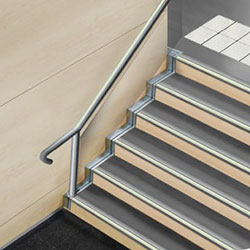









In today's world, universal design and human-centric thinking have become indispensable pillars of any well-planned built environment. The idea of designing for all people, regardless of physical ability, age, or other factors, creates welcoming public realms that integrate accessibility seamlessly.
Tactile solutions play a vital role in putting human-centric design into practice. As a leading Canadian provider of tactile warning systems for over a decade, we at Tactile Solution Canada recognize how thoughtful tactile design caters to diverse needs and creates intuitive spaces.
This blog explores how tactile technologies enhance the human experience through an accessibility lens. We discuss key principles of human-centric design, showcase innovative applications of tactile solutions, and provide guidance on elevating tactile user experience.
The Basics: What is Human-Centric Design? -centric design, also known as user-centric or human-focused design, puts human perspectives and needs at the core of planning. It views problems through a human lens, aiming to deeply understand contextual factors that shape user interactions, pain points, and behaviors.
Armed with human insights, the design process then shapes solutions to enhance usability, accessibility, and experience quality for diverse users.
Here are 10 key principles for a human-focused approach with tactile systems:
Research targets users' abilities, limitations, and accessibility needs. For example, understand how vision impairment impacts public space navigation.
Engineer empathy for the user perspective through immersive observation and feedback. Test designs from a user viewpoint.
Consider the complete user journey. How can tactile guidance enhance wayfinding, safety, independence, and confidence?
Consider the physical, cognitive, and emotional aspects of user experience. How do tactile textures make people feel? How usable are the patterns?
Seamlessly integrate accessibility into designs to be useful naturally, not as an afterthought. Tactile cues should enable intuitive navigation.
Design for diverse physical and mental faculties. Children, the elderly, and those with disabilities have specialized needs.
Intuitive controls, options, and modifications give users more autonomy over environments. Tactile wayfinding enables independent mobility.
Employ agile design improvements based on human feedback. Be open to critiques, suggestions, and new perspectives.
Exceed legal compliance. Champion innovative accessibility solutions and set best practice benchmarks like CSA B651.
Tactile accessibility features give users of all abilities better experiences. Curb cuts aid parents with strollers, too!
By internalizing such human-focused principles, tactile system design can evolve beyond essential compliance into an art form that intimately serves user needs.
Canada's vibrant public spaces and business landscape have seen highly innovative adaptations of tactile solutions to enhance the human experience. Some stellar examples of human-centric tactile design thinking include:
Ontario Science Centre's renowned interactive exhibit on the human body features a giant walk-through heart with tactile textures to explore blood flow. Tactile elements allow visually impaired visitors to engage fully.
Canada's Wonderland has started incorporating tactile maps, guides, and interactive exhibits into its rides to create multi-sensory magical experiences for visitors with visual disabilities.
Vancouver's Museum of Anthropology offers monthly touch tours where blind patrons can appreciate historical objects through 3D-printed replicas and tactile diagrams.
Toronto's Lynett Memorial Park contains a "sensory garden" with scented plants, auditory elements, and tactile gravel walkways tailored to users with special needs.
Cities like Toronto are rolling out platform edge tiles with bright color contrasts and anti-slip coatings to prevent accidents in subway systems.
CIBC Square's modern offices integrate porcelain tactile flooring with an elegant arrow pattern to guide users to reception areas.
Some airports have pioneered interactive tactile installations where patterns shift dynamically based on passenger footsteps and ambient sounds.
Through such creativity, businesses and public spaces are pioneering more inclusive environments attuned to diverse needs.
Here are some professional tips on enhancing tactile user experience based on human factors:
Design mock-ups and engage visually impaired users for feedback through controlled tests. Address any detectability, safety, or usability issues.
Consistently employ familiar tactile, easily interpretable tactile patterns, like truncated domes, for hazard warnings.
Combine tactile experience with audio, visual, and olfactory cues for enhanced detectability. Bright contrasts aid those with low vision.
Offer flexibility in solutions like removable versus permanent tiles. Cater to varied needs and contexts.
Modular tiles allow affordable replacement of damaged sections. Minimize user disruption during maintenance.
Standardized tactile surfaces ensure uniform user experience across different locations, enabling instinctive learning.
Actively engage and incorporate ideas from accessibility advocates to continually optimize designs.
Account for decreased tactile sensitivity with age. Ensure high detectability even with minimal pressure.
Collaborate with accessibility consultants and providers like Tactile Solution Canada to engineer best-in-class human experiences.
Pilot innovative solutions that exceed standards. Forge ahead of competitors in enhancing inclusion, safety, and experience.
Tactile solutions can genuinely empower and delight by ensuring attention to user-centric detail.
Thoughtful human-centric design has profound positive impacts on quality of life:
Human-focused thinking creates more liveable, resilient, and ethically evolved societies. Tactile technologies positively impact millions of lives when designed thoughtfully.
At Tactile Solution Canada, enhancing user experience motivates our mission to make infrastructure accessible. Our extensive range of tailored tactile solutions, from durable metal plates to interactive tiles, aims to give users excellent safety, independence, and ease of access.
Reach out to our experts today to explore how our human-centric approach can craft custom tactile innovations that work for your users and needs.
